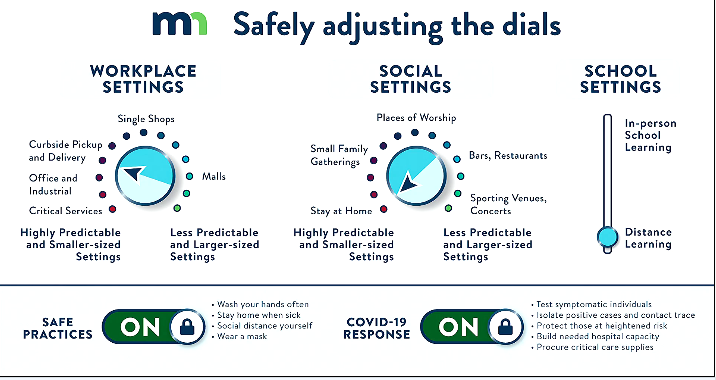5-1-2020 COVID-19 Update from the MN Department of Health
Minnesota Department of Health COVID-19 Update 5-1-2020

The Minnesota Department of Health will hold a conference call today to brief members of the media on the latest public health information regarding COVID-19.
Jan Malcolm, Commissioner, Minnesota Department of Health (MDH):
- Globally 3.3 million cases, 234,000 deaths; 1 million+ cases, 63,000 deaths in U.S.
- 5,730 confirmed cases in MN (an increase of 596 since yesterday); 371 deaths in MN (an increase of 28 – 24 of those at long-term care facilities). Ages of new deaths, 6 in 90s, 10 in 80s, 5 in 70s, 4 in 60s, 3 in 50s.
- 4,124 molecular or PCR tests run Thursday (That’s within reach of goal set by Governor Walz of 5,000 tests per day by Monday, May 4; Gov’s ultimate goal is 20,000 tests per day within 3 to 4 weeks)
- About 80% of all deaths have been among residents of nursing homes or assisted living facilities
- About 40% of the confirmed cases — 2,282 people — have since recovered.
- Through a FEMA channel, will begin receiving about 47,000 nasal swabs per week, increasing testing supplies.
- “It’s very good news” on how testing volume has ramped up rapidly in MN
Kris Ehresmann, Director, MDH Infectious Disease Division:
- Addressed long-term care facility situation. “Long-term care facilities present a special set of considerations and risks because they are congregate care settings serving residents who are advanced age and have one or more underlying health conditions.”
- Working hard to share information with these facilities.
- Conducting post-mortem testing on long-term care deaths
- Doesn’t believe virus is behaving differently in MN compared to rest of country.
Joe Kelly, Director, MN Homeland Security and Emergency Management:
- Wanted to share good news stories on Friday. Help should be on the way for emotional and mental support.
- FEMA funding request “under review” for better part of a month for community-based crisis counseling and outreach.
- Believes state meets criteria for approval
- Working on planning for crisis outreach for last month
Q&A Session & Notes
- On long-term care facilities dealing with staffing issues: MDH: Working on that issue to anticipate staffing challenges. Couldn’t tell exact number of facilities understaffed. “We have to come up with longer-term, durable solutions,” says Commissioner Jan Malcolm. “This is going to be with us a while, unfortunately,” referring to staffing challenges.
- St. Therese of New Hope nursing home confirmed 130 cases to CCX News, highest in state. What is second highest? MDH: There are 21 long-term care facilities with 20+ cases. 99 with just one case. 36 with two cases. Couldn’t divulge second highest number facility.
- Vast majority of cases involving long-term care patients test positive for COVID-19 and pass away.
- Next run of predictive model? Malcolm: will rerun University of Minnesota 3.0 model mid-week next week. (this model gathering peer review from across the country.). Will be made public on mn.gov/covid19
- 80% of COVID-19 deaths at long-term care facilities. What can be done? Malcolm says these individuals are fragile to begin with.
- Malcolm: A majority of long-term care facilities “have done an excellent job” preparing and preventing spread of virus. Six weeks since we saw first case. Didn’t know at beginning about asymptomatic spread – that has caused difficulty at congregate care settings. Moving people out of long-term care “can be dangerous and disruptive as well”
- Ehresmann: Families need loved ones at long-term care facilities, which have higher level of special care. It’s why many can’t go back to a family member’s home. Also on some of these deaths, the individuals don’t want to be intubated per a health care directive, contributes to higher fatality rates at nursing homes.
- On staffing issues at long-term care facilities. Is there evidence of spread occurring between staff members and long-term care residents? Answer: Looking at proper protocols. “These are all things we are continuing to look at,” said Malcolm.
- Ehresmann: We have learned more about asymptomatic transmission. 48 hours before onset of symptoms. “Someone could be working without symptoms and not realize that they had COVID.”
- Ehresmann: “We are seeing COVID in facilities because it’s in the community and it’s being unwittingly spread” “We want to be aggressive working with facilities” to increase proportion of single or low-number calls.
- Why extend stay-at-home order? Malcolm: “This is an unprecedented event.” “Not a dumb question at all.” “I think from my perspective we do have an index of caution. We are seeing the case numbers increase rapidly.” “There is some reluctance to open up more broadly when we feel like we could be on the verge of a tipping point we’ve seen in other communities.” Fed government guidance: Need 14 days of consecutive decline of cases. “We’re a long way from that,” she said.
- Question: will MDH be able to measure that opening up economy is creating more infections? 15% of cases where no contact is identified. Malcolm: It’s going to very hard to determine what’s driving what. It’s not just testing results we’re looking at regarding opening up decisions.
- Ehresmann: “We are doing more testing, but we’re also are doing more focused testing.” “We’ve done a lot of testing of facilities where we know there’s spread.” But Ehresmann said, “there’s a lot cases beyond what we’ve been identifying.”
- On contact tracing (identifying who’s been in contact with an infected person). It’s been a challenge, said Ehresmann. In the case of JBS meat-packing plant in Worthington, Minn., there are 58 different languages spoken among workers at that plant. Not been able to contact trace within 24 hours.
See the recap from yesterday’s announcement From MN Governor Tim Walz Here
- Current status of MN Governor’s safety dials to reopen the state:

 How COVID-19 is impacting our community
How COVID-19 is impacting our community
Find all of our latest COVID-19 stories here
Brooklyn Center | Brooklyn Park | Crystal | Golden Valley | Maple Grove | New Hope | Osseo | Plymouth | Robbinsdale


